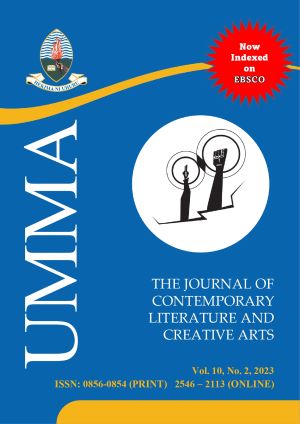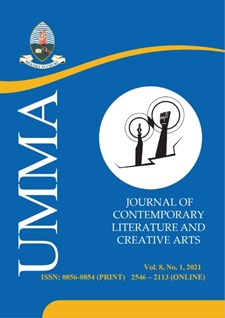Counterfeit Glass Beads during the East African Caravan Trade: Mineralogical and Gemmological Analysis
Abstract
This article presents results from mineralogical and gemmological analyses of imperfectly made tubular beads excavated at Kilwa Kivinje, a 19th century coastal caravan terminus in southern Tanzania. These beads are unique in size, their material, and colour, in addition to lacking treated cut ends. Because of their distinctive flaw, these beads required thorough laboratory analyses to determine how they compare to other glass beads from the same archaeological context. Although 19th century European travellers ' accounts insist on glass beads being the popular commodity during the East African caravan trade, mineralogical and gemmological analyses revealed some of these beads to have been crafted from low-grade non-glass material. This prevented their standardisation in cut lengths, the permanency of coated colours, and the cut-ends treatment. These results justify speculation that these were counterfeits designed to pass for the original glass beads, possibly due to limited supply amidst high demand and the rapidly changing customer tastes for the much sought-after glass beads in East Africa during the height of the caravan trade. This is the first archaeological study in the region to examine the quality of traded glass beads during the caravan trade for their authenticity in artistry and material.
Keywords:
Counterfeit glass beads, caravan trade, mineralogical analysis, Kilwa Kivinje, Tanzania
References
Biginagwa, T. J. (2015). Archaeological Investigation at Kilwa Kivinje: A 19th Century Coastal Caravan Terminus in Southern Tanzania: Vol 12. Studies in the African Past 12: 60-97.
Biginagwa, T.J. 2014. ' Historical archaeology in eastern Africa ' . Encyclopedia of global historical archaeology, 2265 €“ 2273.
Biginagwa, T. J. (2012). "Historical Archaeology of the 19thC Caravan Trade in North-Eastern Tanzania:A Zooarchaeology Perceptive."PhD. Thesis, University of York.
Burton, R. (1860). The Lake Regions of central Africa: A picture of exploration I & II. London: Longman
Chami, F. (1998). A review of Swahili archaeology. African Archaeological Review 15: 199 €“ 218.
Chirikure, S. (2014). "Land and Sea Links: 1500 years of connectivity between Southern Africaand the Indian Ocean Rim region AD 700-1700."The African Archaeological Review,705-724.
Chittick, N. (1974). Kilwa: An Islamic Trading City on the East African Coast; The Finds, 2. The British Institute in East Africa, Nairobi.
Croucher, Sarah K. (2011). Exchange Values: Commodities, Colonialism, and Identity on Nineteenth Century Zanzibar. Wesleyan University, Middletown, CT, USA. Springer Science+Business Media, LLC,165-191.
Davison, C.C. (1973). Chemical resemblance of garden roller and M1 glass beads. African Studies 32 (4), 247 €“257
DeCorse, C.R., Richard, I.G. & Thiaw, I. (2003). Toward a systematic bead description system. Journal of African Archaeology 1 (1), 77 €“109.
Freeman Greenville, G. S. P (1962). The East African Coast: Select Documents. Oxford: Clarendon.
Horton, M. (1996). Shanga: The Archaeology of a Muslim Trading Community on the Coast of East Africa. London: BIEA
Horton, M., & Middleton, J. (2000). The Swahili: The Social Landscape of a Mercantile Society. Oxford: Blackwell.
Karklins, K. (1992). Identifying beads used in the 19th century central East Africa trade. Journal of the Society of Bead Researchers 4, 49 €“ 59.
Kidd, K.E., & Kidd, M.A. (1983). A classification system for glass beads for the use of field archaeologists. In Proceedings of the 1982 Glass Trade Bead Conference; Hayes, C.F., III, Ed.; Rochester Research Note 16; Rochester Museum and Science Center: New York, NY, USA, pp. 219 €“257
Kimura, B., & Shenkere, D. (2009). "Beads in Konso, Southern Ethiopia."Proceedings of 16th international conference of Ethiopia studies, pp. 369-381.
Kinahan, J. (2000). "Cattle for Beads, The archaeology of Historical contact and trade on the Namib Coast." Sweden: Department of Archaeology and Ancient History
Laviolette, A. (2008). Swahili cosmopolitanism in Africa and the Indian Ocean world, A.D. 600- 1500. Archaeologies: Journal of the World Archaeological Congress 4: 24 €“49.
Moffett, A., & Chirikure, S. (2016). "Exotica in Context: Reconfiguring Prestige, Power and Wealth in Southern African Iron Age." Journal of World Prehistory, 337-382
Munisi, N.C. (2022). "The Commoner ' s Access to and Consumption Pattern of Imported Beads in Kilwa Kisiwani Ancient Trading City". MA Dissertation. Dar es Salaam: University of Dar es Salaam.
Pallaver, K. (2009). A recognized currency in beads: glass beads as money in the 19th century East African central caravan road. In E. Catherine, H. Fuller and J. Perkins (eds.) Money in Africa. London: The British Museum, 20-29.
Prestholdt, J. (2004). On the Global Repercussions of East African Consumerism. American Historical Review 109(3): 755 €“781.
Robertshaw, P., Wood, M., Melchiorre, E., Popelka-Filcoff, R.S. & Glascock, M.D. (2010). Southern African glass beads: chemistry, glass sources and patterns of trade. Journal of Archaeological Science 37 (8), 1898 €“1912.
Saitowitz, S. (1996). Glass Beads as indicators of contact and trade in Southern Africa ca. AD 900- AD 1250. PhD Dissertation. University of Cape Town.
Schoff, W. H. (1912). The Periplus of the Erythraean sea. New York. pp. 42, I93.
Stine, L, Cabak M, Groover, M. (1996). Blue Beads as African-American Cultural Symbols. Historical Archaeology 30 (3):49-75.
Thomas, N. (1991). Entangled objects: Exchange, material culture, and colonialism in the Pacific. Cambridge: Harvard University Press.
Van der Sleen, W. (1967). A handbook on beads. York, Pennsylvania: George Shumway.
Van der Sleen, W.G.N (1958). Ancient Glass Beads with Special Reference to the Beads of East and Central Africa and the Indian Ocean. The Journal of the Royal Anthropological Institute of Great Britain and Ireland Vol. 88(2): pp. 203-216
Walz, J. and Dussubieux, L. (2022). Inland glass beads in Northeast Tanzania, 8th-17th centuries CE. In: The elemental analysis of glass beads: technology, chronology, and exchange, pp. 265-286, edited by L. Dussubieux & H. Wald. Leuven University Press.
Walz, J. R. (2017). Inland Connectivity in Ancient Tanzania. Islamic Africa, 8(1 ˆ’2): 217 ˆ’227.
Walz, J., and Dussubeuix, L., (2016). Zhizo Series Glass Beads at Kwa Mgogo inland NE Tanzania. Journal of African Archaeology. Vol. 14 (1). pp 99-101.
Wood M., Dussubieux L., & Wadley, L. (2009) A cache of ~5000 glass beads from the Sibudu Cave Iron Age occupation. S Afr Humanities 21: 239 €“261.
Wood, M. (2002). The glass beads of Kaole. In F. Chami, G. Pwiti, and C. Radimilahy (eds.) Southern Africa and the Swahili World. Studies in the African Past 2. Dar-es-Salaam: Dar es Salaam University Press.
Wood, M. (2011). "A Glass Bead Sequence for Southern African from the 8th to 16th C AD." Journal of African Archaeology, 67-84.
Wood, M. (2019). "Glass Beads and Trade in the Western Indian Ocean . Archaeology, Indian Ocean Studies, Middle East, South Asia, Medieval India c.600-1500."
Downloads
Published
Issue
Section
License
- Authors retain copyright and grant the journal right of first publication with the work simultaneously licensed under a Creative Commons Attribution License that allows others to share the work with an acknowledgement of the work's authorship and initial publication in this journal.
- Authors are able to enter into separate, additional contractual arrangements for the non-exclusive distribution of the journal's published version of the work (e.g., post it to an institutional repository or publish it in a book), with an acknowledgement of its initial publication in this journal.
- Authors are permitted and encouraged to post their work online (e.g., in institutional repositories or on their website) prior to and during the submission process, as it can lead to productive exchanges, as well as earlier and greater citation of published work (See The Effect of Open Access).



